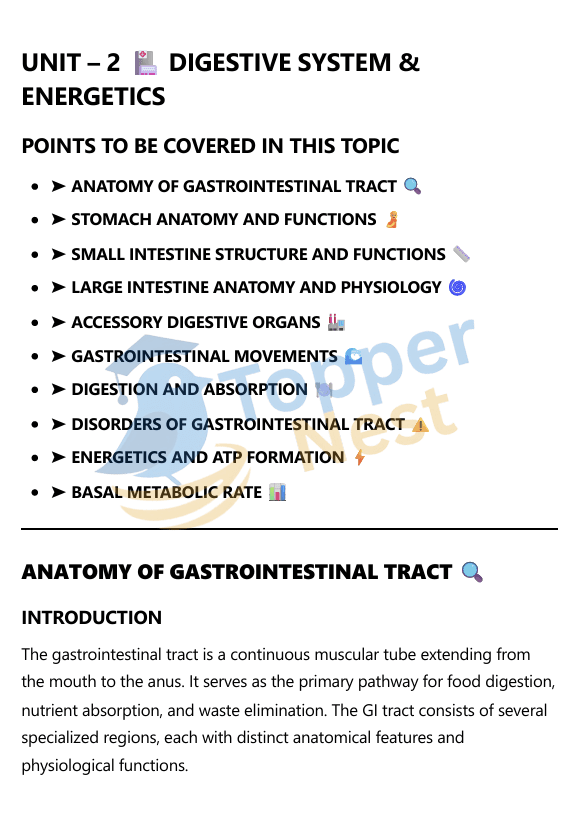The digestive system is like the body’s processing factory — it breaks down the food we eat into simple molecules, absorbs them, and supplies nutrients for energy, growth, and repair. Along with this, the body’s energetics system ensures that energy stored in food is converted into usable biochemical energy (ATP).

Anatomy of the Gastrointestinal (GI) Tract
The Gastrointestinal (GI) tract is a long, muscular tube that extends from the mouth to the anus. Its main function is to digest food, absorb nutrients, and eliminate waste. The GI tract is about 9 meters (30 feet) long and is comprised of several distinct organs, each with a specialized role.
Upper GI Tract
The upper GI tract includes the organs responsible for the initial stages of digestion.
- Mouth: Digestion begins here with the mechanical breakdown of food by chewing and the chemical breakdown of carbohydrates by salivary enzymes.
- Pharynx: The throat, which connects the mouth to the esophagus.
- Esophagus: A muscular tube that transports food from the pharynx to the stomach through a series of rhythmic contractions called peristalsis.
- Stomach: A J-shaped organ that mixes food with digestive juices, including hydrochloric acid and enzymes, to break down proteins. The stomach’s muscular walls churn the food into a semi-liquid substance called chyme.
Lower GI Tract
The lower GI tract is the primary site for nutrient absorption and waste elimination.
Small Intestine: This is where the majority of digestion and absorption occur. It is divided into three sections:
- Duodenum: The first section, where chyme from the stomach mixes with digestive enzymes from the pancreas and bile from the liver.
- Jejunum: The middle section, where most nutrients are absorbed into the bloodstream.
- Ileum: The final section, where vitamins, bile salts, and any remaining nutrients are absorbed. The small intestine’s inner lining has millions of tiny, finger-like projections called villi that increase its surface area for absorption.
Large Intestine: The final section of the GI tract. It absorbs water and electrolytes from the remaining undigested food matter and compacts the waste into feces. It is home to a vast community of beneficial bacteria that play a role in digestion and immune function. It consists of the cecum, colon, and rectum.
Anus: The external opening at the end of the GI tract through which feces are eliminated from the body.
Stomach – Structure & Functions
The stomach is a muscular, J-shaped organ located in the upper abdomen, between the esophagus and the small intestine. It plays a central role in the initial stages of digestion by mixing and breaking down food.
Structure of the Stomach
The stomach is a highly adaptable organ with four main regions:
- Cardia: The top-most section, where the esophagus connects to the stomach.
- Fundus: A dome-shaped area to the left of the cardia that stores gas and food.
- Body (Corpus): The largest central part of the stomach, where the bulk of digestion occurs.
- Pylorus: The bottom part of the stomach that connects to the small intestine. The pyloric sphincter, a muscular valve, controls the release of food into the small intestine.
The stomach wall has four layers:
- Mucosa: The innermost layer, containing gastric glands that produce digestive juices, enzymes, and mucus.
- Submucosa: A layer of connective tissue that contains blood vessels, nerves, and lymphatic vessels.
- Muscularis Externa: A thick layer of muscle with three sub-layers that churn food to help with mechanical digestion.
- Serosa: The outermost protective layer.
Functions of the Stomach
The stomach performs several critical functions in the digestive process:
- Storage: It temporarily stores food, allowing it to be released into the small intestine at a manageable rate.
- Mechanical Digestion: The powerful muscular contractions of the stomach wall churn and mix food with gastric juices, breaking it into a semi-liquid substance called chyme.
- Chemical Digestion: The gastric glands secrete hydrochloric acid (HCl) and enzymes like pepsin. HCl denatures proteins and kills bacteria, while pepsin begins the chemical breakdown of proteins into smaller polypeptides.
- Absorption: The stomach absorbs only a few substances, such as alcohol, aspirin, and some water. Most nutrient absorption happens in the small intestine.
- Secretion: It secretes intrinsic factor, a protein essential for the absorption of vitamin B12 in the small intestine.
Energetics
Energetics is the study of energy transfer and transformation in living organisms. It’s a fundamental concept in biology that explains how organisms get the energy they need to carry out all their life processes, such as growth, movement, and reproduction. The core principle of energetics is that energy cannot be created or destroyed, only converted from one form to another.
Key Concepts in Energetics
- Photosynthesis: The process used by plants, algae, and some bacteria to convert light energy into chemical energy. In this process, organisms use sunlight to synthesize glucose (a sugar) from carbon dioxide and water. The energy is stored in the chemical bonds of the glucose molecule.
- 6CO2+6H2O+Light Energy→C6H12O6+6O2
- Cellular Respiration: The process by which organisms release the chemical energy stored in glucose. It occurs in the mitochondria of cells and converts glucose and oxygen into usable energy in the form of ATP (adenosine triphosphate), along with carbon dioxide and water as byproducts.
- C6H12O6+6O2→6CO2+6H2O+ATP (Energy)
- ATP (Adenosine Triphosphate): Often called the “energy currency” of the cell. ATP is a high-energy molecule that stores and transfers energy within cells, powering nearly all cellular activities.
Energy Flow in Ecosystems
Energetics also helps us understand the flow of energy through ecosystems. Energy from the sun is captured by producers (plants) through photosynthesis. This energy is then transferred to consumers when they eat the producers, and so on, up the food chain. However, energy is lost at each step, primarily as heat, which is why food chains typically have only a few levels.
